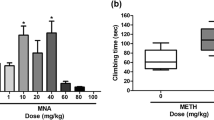Abstract
Rationale: Chronic treatment with the monoamine oxidase inhibitor (MAOI) clorgyline, blocks locomotor sensitization to the D2/D3 dopamine agonist quinpirole. It is unknown whether this blockade occurs via inhibition of the MAO enzyme or by another mechanism. Objectives: While clorgyline and moclobemide are equally effective MAOIs, only clorgyline has a high affinity for the MAOI-displaceable quinpirole binding site (MQB). This study compares the effects of both drugs on quinpirole sensitization. Methods: To examine development of sensitization, rats received clorgyline (1 mg/kg/day), moclobemide (5 mg/kg/day), or vehicle via osmotic mini-pumps and were injected with quinpirole (0.5 mg/kg, s.c.) or saline every 3 days; locomotor and mouthing activity was recorded for each of the eight injections. A similar protocol was used to examine the expression of sensitization in rats previously sensitized to quinpirole. Results: Clorgyline, but not moclobemide, blocked the development of locomotor sensitization to quinpirole. Clorgyline, but not moclobemide, blocked the sensitized locomotor response to quinpirole following the 25th day of treatment. Mouthing showed sensitization in quinpirole-treated rats co-treated with clorgyline, but not moclobemide; this sensitized mouthing was predominantly directed towards self. Clorgyline and moclobemide equally inhibited MAO-A and had equal effects on tissue concentrations of dopamine, 3,4- dihydroxyphenylacetic acid, and serotonin in the striatum. Conclusions: Clorgyline (1) inhibits the development and the maintenance of locomotor sensitization to quinpirole by a mechanism that does not involve MAO and (2) changes the sensitized response to quinpirole from locomotion to mouthing. We suggest that clorgyline affects the response to quinpirole via MQB and that this site acts as a switch that selects the motor pathway for sensitization to quinpirole.
Similar content being viewed by others
Author information
Authors and Affiliations
Additional information
Received: 9 August 1999 / Accepted: 18 November 1999
Rights and permissions
About this article
Cite this article
Culver, K., Rosenfeld, J. & Szechtman, H. A switch mechanism between locomotion and mouthing implicated in sensitization to quinpirole in rats. Psychopharmacology 151, 202–210 (2000). https://doi.org/10.1007/s002139900346
Issue Date:
DOI: https://doi.org/10.1007/s002139900346




